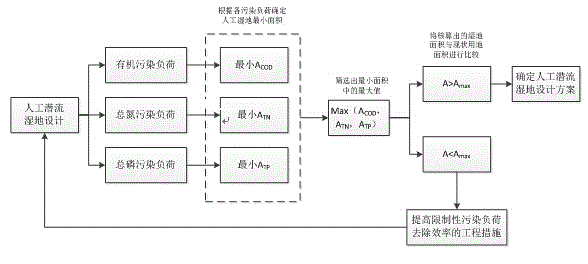Design method based on three-pollution load for subsurface constructed wetland
A technology of constructed wetlands and pollution load, applied in the field of constructed wetland area measurement, can solve the problems of scientific design of constructed wetlands, wetland effluent water quality cannot meet the expected treatment effect, affect pollutant removal efficiency and other problems, and achieve the goal of ensuring water quality purification effect Effect
- Summary
- Abstract
- Description
- Claims
- Application Information
AI Technical Summary
Problems solved by technology
Method used
Image
Examples
Embodiment 1
[0031] Example 1
[0032] according to figure 1 The instructions carefully describe the design method:
[0033] Based on three pollution load response / adsorption kinetic models, mainly considering the relationship between the pollutant treatment load of constructed wetlands and the required wetland area, three kinds of pollution load-area equations are established and derived:
[0034]
[0035] At the same time, it is necessary to maintain a certain hydraulic retention time to meet the requirements of nitrification-denitrification time.
[0036]
[0037] The required parameters of the model are as follows:
[0038]
[0039] Table Model parameter table
[0040] According to the designed artificial subsurface flow wetland's daily sewage treatment volume, influent sewage water quality and effluent water quality requirements, solve the equations to obtain the minimum area required for the artificial wetland based on organic pollutants, nitrogen, and phosphorus loads, a...
Embodiment 2
[0042] A design method for constructed wetlands based on three pollution load subsurface flows: using the method of determining the area of constructed wetlands based on three types of pollution loads, comprehensively considering the purification mechanism and efficiency of different pollutants in constructed wetlands, and designing the area parameters of constructed wetlands, the procedure is :
[0043](1) According to the artificial subsurface flow wetland organic pollutants, total nitrogen, and total phosphorus three pollution loads, respectively calculate the minimum surface area required for the artificial subsurface flow wetland that meets the pollution removal conditions of the three types of pollution;
[0044] (2) Select the maximum surface area of the artificial subsurface flow wetland that meets the above conditions as the design area of the artificial subsurface flow wetland; compare the design area with the actual usable land area, if the design area is s...
Embodiment 3
[0055] Taking the design of an artificial subsurface flow wetland as an example, the design method of the subsurface flow constructed wetland based on three pollution loads is illustrated. The available wetland area of the research object to be constructed is 25ha, the thickness of the substrate layer of the artificial subsurface flow wetland is designed to be 1m, and the slope is designed to be 0.01. The influent COD concentration is 60mg / L, and the designed effluent COD concentration is 50mg / L; the influent TN concentration is 20mg / L, and the designed effluent TN concentration is 15mg / L; the influent TP concentration is 1mg / L, and the designed effluent TP concentration is 0.5mg / L; the preliminary wetland design plants are mainly reeds, and the wetland filler is gravel. The water temperature is 20°C, and the daily sewage treatment volume is 17,500m 3 / d.
[0056] (1) Wetland area design based on organic pollution load
[0057] The preliminary design of the horizontal sub...
PUM
| Property | Measurement | Unit |
|---|---|---|
| porosity | aaaaa | aaaaa |
Abstract
Description
Claims
Application Information
 Login to View More
Login to View More - R&D
- Intellectual Property
- Life Sciences
- Materials
- Tech Scout
- Unparalleled Data Quality
- Higher Quality Content
- 60% Fewer Hallucinations
Browse by: Latest US Patents, China's latest patents, Technical Efficacy Thesaurus, Application Domain, Technology Topic, Popular Technical Reports.
© 2025 PatSnap. All rights reserved.Legal|Privacy policy|Modern Slavery Act Transparency Statement|Sitemap|About US| Contact US: help@patsnap.com



